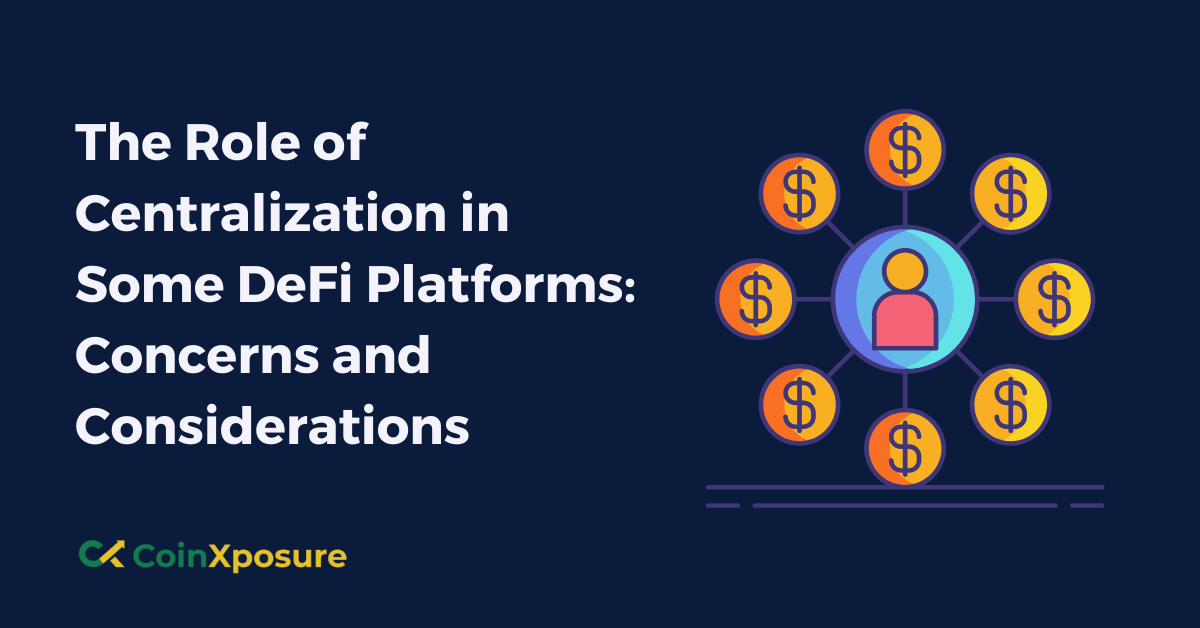
The Role of Centralization in Some DeFi Platforms – Concerns and Considerations
Decentralized Finance (DeFi) has emerged as a revolutionary force in the financial landscape, offering an alternative to traditional centralized systems.
However, amidst the ethos of decentralization, some DeFi platforms incorporate elements of centralization.
This article explores the role of centralization in certain DeFi platforms, highlighting the associated concerns and considerations.
While decentralization is often touted as a cornerstone of DeFi, the presence of centralization introduces complexities that warrant examination.
By delving into these nuances, we can better understand the evolving nature of DeFi and navigate the challenges and opportunities it presents.
Centralization in DeFi Platforms
Centralization in DeFi Platforms refers to the presence of centralized elements within decentralized finance ecosystems.
While DeFi aims to create financial systems that operate without central authorities, some platforms incorporate centralized components for various reasons.
These elements may include centralized governance structures, decision-making processes, or control over funds.
While centralization can offer benefits such as efficiency and scalability, it also raises concerns regarding security vulnerabilities, loss of decentralization, and regulatory scrutiny.
Finding a balance between decentralization and centralization is crucial for the continued evolution and adoption of DeFi platforms.
Concerns Associated with Centralization in DeFi Platforms
Concerns Associated with Centralization in DeFi Platforms revolve around several key areas:
- Security Risks
- Loss of Decentralization
- Trust Dependency
Security Risks
Centralization introduces a single point of failure, making platforms more vulnerable to hacks and exploits. With centralized control over critical functions or funds, the impact of security breaches can be severe.
Loss of Decentralization
DeFi platforms aim to operate without central authorities, promoting censorship resistance and user autonomy.
Centralized elements undermine this ethos, potentially leading to increased reliance on trusted intermediaries and compromising the decentralized nature of the ecosystem.
Trust Dependency
Centralization may require users to trust platform operators or centralized entities, contradicting the trustless nature of DeFi.
This reliance on centralized parties can erode confidence in the platform and hinder its adoption by users seeking truly decentralized solutions.
Addressing these concerns requires careful consideration of the trade-offs between centralization and decentralization, as well as the implementation of robust security measures and transparent governance practices within DeFi platforms.
Considerations for Centralization in DeFi Platforms
Considerations for Centralization in DeFi Platforms encompass various strategies and principles aimed at mitigating associated risks while leveraging potential benefits:
- Finding a Balance
- Transparency and Accountability
- Risk Management Strategies
Finding a Balance
Striking a balance between decentralization and centralization is essential.
Platforms may adopt hybrid models that incorporate centralized elements where necessary for efficiency or scalability, while preserving decentralized principles in areas critical to user autonomy and censorship resistance.
Transparency and Accountability
Ensuring transparency in the disclosure of centralized elements and decision-making processes builds trust among users.
Platforms can enhance accountability through clear governance frameworks, community engagement, and mechanisms for user participation in key decisions.
Risk Management Strategies
Implementing robust risk management strategies is crucial to mitigate the impact of security breaches or regulatory challenges.
This includes conducting regular security audits, implementing multi-layered security protocols, and establishing contingency plans to address potential vulnerabilities or disruptions.
By carefully considering these factors, DeFi platforms can navigate the complexities of centralization, mitigate associated risks, and foster sustainable growth while preserving the core tenets of decentralization.
Conclusion
The role of centralization in some DeFi platforms presents a complex landscape of concerns and considerations.
While centralization can offer benefits such as efficiency and scalability, it also introduces risks related to security vulnerabilities, loss of decentralization, and regulatory scrutiny.
Striking a balance between centralization and decentralization is essential, along with transparency, accountability, and robust risk management strategies.
Moving forward, DeFi platforms must carefully navigate these challenges, embracing decentralization where it aligns with the ethos of the ecosystem, while pragmatically incorporating centralized elements where necessary for practicality and scalability.
By doing so, they can foster sustainable growth, enhance user trust, and contribute to the continued evolution of decentralized finance as a transformative force in the financial landscape.





